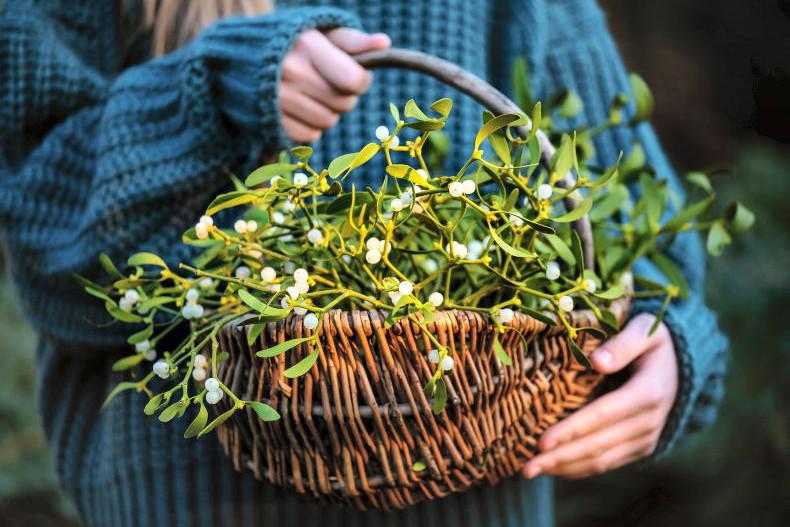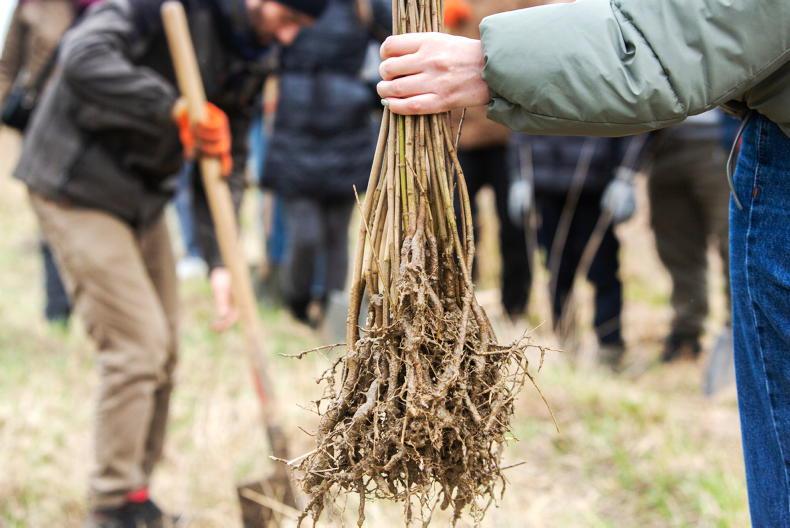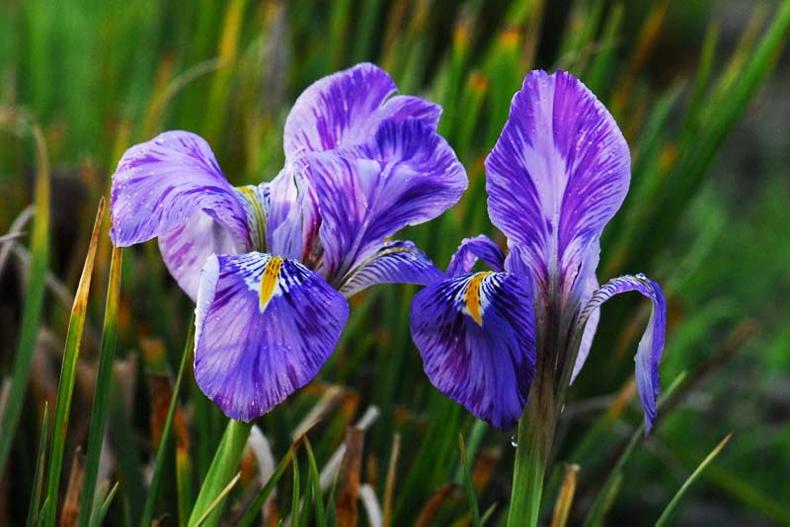The foliage has varied colour, shape, size and it is held on the plant in a variety of ways, giving the maple great variation of size and shape of plant. Leaves are plain green, bronze, red, to deep purple and, fortunately, not many ‘nishiki’ or variegated kinds. The foliage varies in size and shape too, some kinds having deeply cut – almost feathery – leaves and other with solid leaves, just divided into five fingers, which is where the Japanese maple, Acer palmatum, gets its second name, “palmatum” meaning like the palm of the hand. The spring foliage, in shades of yellow, bright green, orange, pink, bronze and red is as beautiful as the brilliant autumn colour.

Ferns unfurl in spring.
Some kinds are quite upright in growth and these varieties have an erect, narrow appearance. Others are the exact opposite, the twigs weeping downwards and trailing on the soil, and these form low mushroom shapes. Between the extremes, there are many variations that give each variety a distinctive tree shape. The smallest kinds are no more than about a half-metre tall whereas the tallest ones can soar to over 10 metres. These are all of the same species, derived by selective breeding over hundreds of years in Japan and later in America and Holland.
There are many good varieties of Japanese maple out of the hundreds that exist. There is so much variation that almost any batch of seedlings will produce some different, though not necessarily of exceptional quality. The plain green ordinary Japanese maple is still one of the best. It makes the biggest tree and grows strongly, being tougher than most. The purple-leaved form, Acer palmatum “Atropurpureum” is a good tree and very popular because the rich wine-purple colour that contrasts so well with the general green of garden shrubs and trees.
A form of this is “Bloodgood” with richer colour that does not fade to red as most do under the summer sun. One of the toughest kinds is “Osakazuki”, which has smallish, not much divided leaves, that are more durable than the finer kinds.
The small weeping kinds that form mounds are “Dissectum” and there is the purple form, “Dissectum Atropurpureum”. These are delicate with very divided foliage and cannot take any significant wind exposure. They look especially well on a bank and can be grown in large pots for years. An outstanding vigorous kind is “Trompenburg” with rolled leaves that resemble bamboo in the way they dangle. There is a green form too, but fairly rare.
The coral-bark maple, “Sango Kaku” is outstanding in spring for its pale orange, and in winter with its red bark and it has lovely yellow autumn colour.
The variety “Chitoseyama” is intermediate between the taller kinds and mounds, giving a tall mound with graceful drooping branches and beautiful bronzed leaves. These varieties, at least some of them, are generally for sale and there are others offered from time to time.
To grow Japanese maple successfully, shelter is important; only the green basic kind and “Osakazuki” are reliable if it is windy.
The others get badly damaged on the windy side. They do not need acid soil but colour best in acid areas, and like plenty of humus. They can be grown in a large pot but become weak after a few years, and are better in the open soil. While they can survive in light shade, they grow best in good sunshine.
In recent years, the horse chestnut scale insect has become a threat, causing severe die-back. Scale insect looks like tiny oysters and can be killed by dabbing on methylated spirits or by spraying insecticide.
During the late spring and early summer, they add a great touch of fresh new foliage. Being woodland plants, they are perfectly adapted for growing in shade. They can be tucked in under trees and shrubs as shade-tolerant ground cover, that will help to prevent weeds in that area. They look especially well under Japanese maple.

Ferns unfurl in spring.
The ferns actually help to shade out weeds by taking a share of the light for themselves. Even though the leaves are thin and almost transparent, the light is absorbed and made unavailable to weeds. Any kind of ferns will perform this task, including the wild ferns that self-spore in shady areas. These can be lifted and moved into shady areas in the garden where reliable ground cover is needed. It is not the ideal time now to lift them, best done in late autumn.
Lawns
Lawns are unlikely to need feeding for a while because grass growth has been quite good in most parts but any lawn that is slow to recover should now get some lawn fertiliser or high-nitrogen fertiliser. Carry out any lawn repairs or over-sowing soon in case of a dry spell. Trim the edges around flower beds or borders, before the grass gets long.
Fruit, vegetables and herbs
Finish off sowing of maincrop vegetables such as carrots, broccoli and peas. Repeat sowings of those sown early, such as lettuce and peas, could be made. Thin out vegetables. Sow or plant herb seeds cabbage and cauliflower for autumn and winter use. It is a little early still to plant out tender vegetables such as sweet corn and runner beans.
Trees, shrubs and roses
Tie in the new shoots of climbing roses early so that they will be in the correct position for training later. Continue to spray roses against blackspot disease, especially in the damper parts of the country and after wet weather. Prune spring shrubs as they go out of flower, if necessary. There are two reasons for pruning; lack of space and the production of a better shape.
Flowers
Bedding plants can be planted out in the coming two weeks or so. Do not be in a hurry with these unless you are in the south of the country. Although rarely killed outright, bedding plants can get a bad check even on a night of light frost and never perform well afterwards. Dahlias and gladiolus can now be planted out where they are to flower.
Greenhouse and houseplants
Plant out tomatoes, chilli peppers, cucumbers and sweet peppers as soon as space becomes available in the greenhouse. They are available in garden outlets. Feed greenhouse plants strongly now to get good growth before mid-summer and water well. Spray a grapevine if it had mildew disease last year. Houseplants can be repotted without delay.
Read more
In the garden with Gerry Daly: irises in May
In the garden with Gerry Daly: red campion
The foliage has varied colour, shape, size and it is held on the plant in a variety of ways, giving the maple great variation of size and shape of plant. Leaves are plain green, bronze, red, to deep purple and, fortunately, not many ‘nishiki’ or variegated kinds. The foliage varies in size and shape too, some kinds having deeply cut – almost feathery – leaves and other with solid leaves, just divided into five fingers, which is where the Japanese maple, Acer palmatum, gets its second name, “palmatum” meaning like the palm of the hand. The spring foliage, in shades of yellow, bright green, orange, pink, bronze and red is as beautiful as the brilliant autumn colour.

Ferns unfurl in spring.
Some kinds are quite upright in growth and these varieties have an erect, narrow appearance. Others are the exact opposite, the twigs weeping downwards and trailing on the soil, and these form low mushroom shapes. Between the extremes, there are many variations that give each variety a distinctive tree shape. The smallest kinds are no more than about a half-metre tall whereas the tallest ones can soar to over 10 metres. These are all of the same species, derived by selective breeding over hundreds of years in Japan and later in America and Holland.
There are many good varieties of Japanese maple out of the hundreds that exist. There is so much variation that almost any batch of seedlings will produce some different, though not necessarily of exceptional quality. The plain green ordinary Japanese maple is still one of the best. It makes the biggest tree and grows strongly, being tougher than most. The purple-leaved form, Acer palmatum “Atropurpureum” is a good tree and very popular because the rich wine-purple colour that contrasts so well with the general green of garden shrubs and trees.
A form of this is “Bloodgood” with richer colour that does not fade to red as most do under the summer sun. One of the toughest kinds is “Osakazuki”, which has smallish, not much divided leaves, that are more durable than the finer kinds.
The small weeping kinds that form mounds are “Dissectum” and there is the purple form, “Dissectum Atropurpureum”. These are delicate with very divided foliage and cannot take any significant wind exposure. They look especially well on a bank and can be grown in large pots for years. An outstanding vigorous kind is “Trompenburg” with rolled leaves that resemble bamboo in the way they dangle. There is a green form too, but fairly rare.
The coral-bark maple, “Sango Kaku” is outstanding in spring for its pale orange, and in winter with its red bark and it has lovely yellow autumn colour.
The variety “Chitoseyama” is intermediate between the taller kinds and mounds, giving a tall mound with graceful drooping branches and beautiful bronzed leaves. These varieties, at least some of them, are generally for sale and there are others offered from time to time.
To grow Japanese maple successfully, shelter is important; only the green basic kind and “Osakazuki” are reliable if it is windy.
The others get badly damaged on the windy side. They do not need acid soil but colour best in acid areas, and like plenty of humus. They can be grown in a large pot but become weak after a few years, and are better in the open soil. While they can survive in light shade, they grow best in good sunshine.
In recent years, the horse chestnut scale insect has become a threat, causing severe die-back. Scale insect looks like tiny oysters and can be killed by dabbing on methylated spirits or by spraying insecticide.
During the late spring and early summer, they add a great touch of fresh new foliage. Being woodland plants, they are perfectly adapted for growing in shade. They can be tucked in under trees and shrubs as shade-tolerant ground cover, that will help to prevent weeds in that area. They look especially well under Japanese maple.

Ferns unfurl in spring.
The ferns actually help to shade out weeds by taking a share of the light for themselves. Even though the leaves are thin and almost transparent, the light is absorbed and made unavailable to weeds. Any kind of ferns will perform this task, including the wild ferns that self-spore in shady areas. These can be lifted and moved into shady areas in the garden where reliable ground cover is needed. It is not the ideal time now to lift them, best done in late autumn.
Lawns
Lawns are unlikely to need feeding for a while because grass growth has been quite good in most parts but any lawn that is slow to recover should now get some lawn fertiliser or high-nitrogen fertiliser. Carry out any lawn repairs or over-sowing soon in case of a dry spell. Trim the edges around flower beds or borders, before the grass gets long.
Fruit, vegetables and herbs
Finish off sowing of maincrop vegetables such as carrots, broccoli and peas. Repeat sowings of those sown early, such as lettuce and peas, could be made. Thin out vegetables. Sow or plant herb seeds cabbage and cauliflower for autumn and winter use. It is a little early still to plant out tender vegetables such as sweet corn and runner beans.
Trees, shrubs and roses
Tie in the new shoots of climbing roses early so that they will be in the correct position for training later. Continue to spray roses against blackspot disease, especially in the damper parts of the country and after wet weather. Prune spring shrubs as they go out of flower, if necessary. There are two reasons for pruning; lack of space and the production of a better shape.
Flowers
Bedding plants can be planted out in the coming two weeks or so. Do not be in a hurry with these unless you are in the south of the country. Although rarely killed outright, bedding plants can get a bad check even on a night of light frost and never perform well afterwards. Dahlias and gladiolus can now be planted out where they are to flower.
Greenhouse and houseplants
Plant out tomatoes, chilli peppers, cucumbers and sweet peppers as soon as space becomes available in the greenhouse. They are available in garden outlets. Feed greenhouse plants strongly now to get good growth before mid-summer and water well. Spray a grapevine if it had mildew disease last year. Houseplants can be repotted without delay.
Read more
In the garden with Gerry Daly: irises in May
In the garden with Gerry Daly: red campion











SHARING OPTIONS